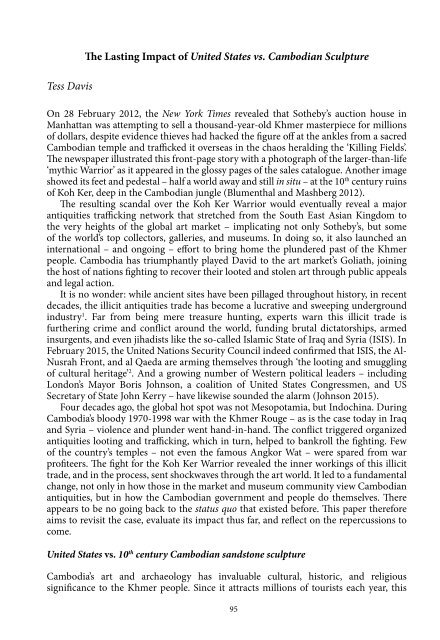Countering
Book_observatory_illicit_traffic_version%20issuu
Book_observatory_illicit_traffic_version%20issuu
You also want an ePaper? Increase the reach of your titles
YUMPU automatically turns print PDFs into web optimized ePapers that Google loves.
Tess Davis<br />
heritage is also one of their most important economic resources. With the country now<br />
at peace, preservation has therefore become a matter of national pride, and increasingly<br />
a State priority.<br />
The day after the New York Times piece came out, the Koh Ker Warrior was also<br />
front page news in Phnom Penh (Vrieze 2012). However, by then, beyond the reach of<br />
the headlines and behind the scenes, Cambodia and Sotheby’s were already deep into<br />
negotiations. A wealthy donor had even stepped forward, pledging the auction house<br />
$1,000,000 to repatriate the statue, but Sotheby’s had refused this offer, continuing to<br />
demand the full catalogue price (Roasa 2015).<br />
Having reached a dead end in the negotiations, Phnom Penh accepted the help of<br />
the United States Department of Justice. On 12 April 2012, at the Kingdom’s request, the<br />
US Attorney for the Southern District of New York filed a civil forfeiture action against<br />
Sotheby’s seeking to seize, recover and return the Warrior. As an in rem action, brought<br />
against the property itself, the case received the somewhat whimsical name of United<br />
States vs. 10 th Century Cambodian Sandstone Sculpture.<br />
US vs. Cambodian Sculpture charged that the Koh Ker Warrior was ‘stolen property<br />
introduced into the United States contrary to law’ – including the National Stolen<br />
Property Act, anti-smuggling laws, and customs laws 3 . Strengthened by internal emails<br />
from Sotheby’s, the complaint revealed that the auction house’s own expert had warned<br />
them the piece was ‘definitely stolen’, and suggested that its owners ‘might want to offer it<br />
back to the National Museum of Cambodia as a gesture of good will and save everyone<br />
some embarrassment’. Six months later the government amended this complaint with<br />
more serious allegations, suggesting that the Koh Ker Warrior was not only stolen<br />
property, but what the press and public was increasingly labeling a ‘blood antiquity’<br />
(Vlasic and Davis 2012).<br />
According to the new evidence released by the Department of Justice, the Koh Ker<br />
Warrior had been looted around 1972, in the midst of the country’s violent civil war<br />
with the Khmer Rouge. Moreover, it had been removed from territory under communist<br />
control, at least raising the possibility that its theft may have been carried out by the<br />
Khmer Rouge themselves. An organized trafficking network had then smuggled it as<br />
parts to a prominent collector Bangkok, and from there onward to Europe, where a<br />
premier London gallery quietly sold it to none other than Belgian royalty in 1975 4 .<br />
That same year, Phnom Penh fell to the communists, beginning one of the 20 th century’s<br />
darkest periods. In the genocide that followed, two million Cambodians (a full fourth<br />
of the population) would die from murder, starvation and disease. And the sculptures<br />
that had adorned and guarded their nation’s temples for millennia – outlasting empires,<br />
nature, and time itself – also fell victim, vanishing into the global black market by the<br />
thousands, if not tens of thousands. Centuries’ worth of sacred relics flooded overseas,<br />
war loot sought after as fine art, and then sold to the highest bidder. An increasing body<br />
of research indicates that this organized traffic in Cambodian antiquities helped to<br />
finance all sides in the fighting, including the Cambodian army, paramilitary factions,<br />
and indeed the Khmer Rouge themselves. And while this illicit trade only started<br />
with the civil war, it has long outlasted it, continuing to this very day (Mackenzie and<br />
Davis 2014).<br />
However, despite the duration and scale of this black market traffic in Cambodian<br />
conflict antiquities, few had resurfaced when US vs. Cambodian Sculpture went to<br />
court. But it would not take long for the New York Times to identify another five major<br />
96


